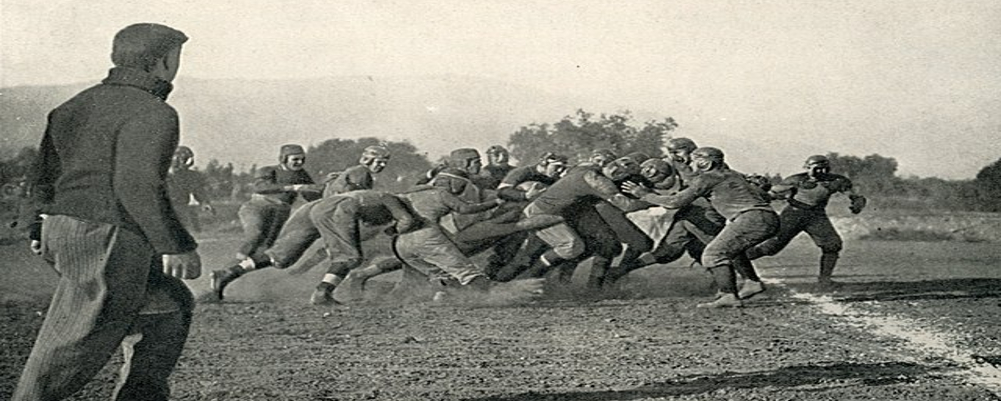This post welcomes Timothy Brown of Football Archaeology as he delves into the murky origins of this deceptive play, exploring its evolution from a potential improvisation to a strategic weapon in the modern NFL. We'll examine the technical aspects of the shovel pass, its tactical advantages, and the impact it has had on the way offenses approach moving the ball downfield. Prepare to get down and dirty, as we uncover the surprising history and strategic power of the shovel pass.
You can find Tim's original Tidbit on this subject complete with images, at ESlowing The Pass Rush With A Shovel.
Transcription of Slow Pass Rush with a Shovel with Timothy Brown
Hello, my football friends. This is Darin Hayes of PigskinDispatch.com. Welcome once again to The Pig Pen, your portal to positive football history, and welcome to another day where we get to visit with our friend Timothy P. Brown of FootballArcheology.com. Tim, welcome back to The Pig Pen. Thank you.
Thank you, sir. This is a good opportunity for us to go Dutch on this podcast. To go Dutch on this podcast.
Dutch Myer was the coach. Oh, okay. All right.
I had to think about that for a second. I thought, you know. Well, this shows that, you know, this is not rehearsed, right? Right, right.
You're name dropping already. I throw these singers out at you and you're like. Usually it's a dad joke segue into the title.
And the title, folks, and this is my confusion, is slowing the pass rush with a shovel. So I'm trying to think what Dutch, if he's doing a play on the word on ditch or, you know, I don't know. Dutch Meyer.
Dutch Meyer. Okay. Well, why don't you tell us a story about Dutch Meyer and what he has to do with the pass rush being slowed? Yeah.
So, I mean, this is, you know, I mean, nowadays we had a recent podcast about the draw play, which, you know, has, you know, is basically kind of shows up probably in the late thirties and then, but really became more commonplace. The draw play that we now know, probably more late forties, you know, kind of a play. And so this idea of, you know, but so the whole purpose of the draw play is to give the defense one look, you know, you're showing them pass when you're actually running it.
Well, before they develop the draw play, they still had the same need of trying to deceive the defense. And one of the ways that they developed best as I can tell, you know, around the early 32, 31, 32 kind of timeframe was the shovel pass. And so, you know, if you think about like a wing T formation at the time, they might've had a wing over on the, not wing T, I'm sorry, but you know, single wing.
They might've had a wing over on the right-hand side till back gets a deep snap, you know, from the center. And then the, the wing on the right-hand side crosses comes across the formation and the quarterback doesn't talk some kind of toss or flip, even a shovel pass to that guy as he's going right to left. So, so that was, you know, and it was one of those plays where, you know, as the defense is coming in, you're, you're, you're trying to get it to somebody who's crossing over just so that they have to be looking out is, is this a play that they're going to run? Right.
I mean, is this a, is this something I need to guard against? And so it was one of the, one of the ways to slow down the pass rush. And there weren't very many of them back then. There weren't very many ways to slow them down was to, was a shovel pass.
So in the 39 Cotton Bowl game, you know, this was a game where TCU had three players drafted the next year in the first 10 of the NFL draft. And, and what their, the number one pick in the draft was Davey O'Brien, who was TCU's quarterback. And you can see him in the background, but he was, you know, five, eight, you know, fairly stockly built guy, but, you know you know, he was a hell of a hell of a quarterback and just, you know, really smart guy, all that kind of thing.
So, so they were, you know, at the time TCU was one of the teams that threw the ball all over the yard, you know, now nothing like happens today, but you know, when they, they played Carnegie Tech in that game and you know, they, both teams rushed for about 150 yards, but TCU passed for on the order of 250, whereas Carnegie passed for like 60 or so yards. So it was one of those games where, you know, they just, TCU was clearly the better player, but, or the better team, but during the game, they threw eight shovel passes. Right.
So it kind of tells you, I mean, name a game nowadays where, where a team throws eight shovel passes, just doesn't happen, you know, doesn't happen. But for them, that was like one of their central plays because, you know, a lot of the other ways that we, you know, quarterbacks still had to throw the, in college, quarterbacks still had to be five yards behind the line of scrimmage to throw a pass. So none of our bubble screens and none of our quick, quick slants, none of those existed.
They were illegal. And so this was one way that they could slow down the pass was a shovel. So, so they completed five of the eight shovel passes.
And that was one of the ways in the second half, they advanced ball down the field. And because this is also in the days of, you know, essentially no or very limited substitutions. O'Brien, the quarterback kicks the game winning field goal in the fourth quarter.
Right. I mean, it's been a while, you know, since I remember a big time quarterback in a bowl game, kicking a field goal to win the game. Now, I mean, I don't know when the last time was, you know, when that happened, there were, there's been some punters like Greg Martin, you know, he's a guy that, you know, maybe some listeners remember he punted, but it's been, you know, Blanda probably was the last guy that most of us can think of though.
And yeah. But you had Doug Flutie do a drop kick one time, but it got no points. So I don't think it was more of a. Yeah.
I mean, that, that was basically a circus kick. Right. Right.
And which is fine, but you know, for a guy who did the regular kicking for his team, O'Brien was one of the last ones and he was, you know, place kicking, not, not drop kicking. So anyways, it's just, you know, I guess it's just one of those things where, you know, it's one of those period pieces where, you know, where they're using the shovel pass in a way that we don't use today, but make sense that they had developed it. And then the same guy who's throwing the shovel pass is a guy who kicks a game winning field goal.
So then he ends up, you know, he only played like two years in the NFL. He, he ended up, you know, I think he just didn't like the pro game very much. And he was on a really bad team.
And so he ended up, he left, uh, left the NFL and became an FBI agent. That's back in that era where you make more money, you know, working in a grocery store than playing in the NFL too. And you don't get hurt as much.
So, but yeah, the, the shovel pass. So that's, uh, you know, traditionally one of the safest passes to throw because it looks weird when it's an incomplete pass, but it's not a fumble because it's a forward pass if it's dropped and it's hard for defenders to see it because you're sort of hidden behind those, those big guys up front, uh, with the throwing actions. It's really not enunciated like, uh, an over the shoulder passes.
Yeah. The challenge is, you know, it's, it's hard to know now, like how much traffic there was coming in and coming at the quarterback as the guys crossing. Um, you know, I, I didn't find any game film of that particular game.
So, um, Gosh, you would think the defenders would start to get wise to it after a little while. So maybe they just were inept. And then it served its purpose, right? I mean, that's right.
It slowed down the pass rush if they got wise to it, but yeah. Um, or, you know, maybe they left some guy, guy to be a spy or something, but you know, they weren't that bright back then. No, no surprise, especially a Western Pennsylvania team.
God, Carnegie, you know, that's, they should be brilliant. Well, they lost. So yeah, no wonder they're, they don't have a D one program anymore.
Uh, interesting stuff, Tim. That's a, that's a great story. And to hear about Davey O'Brien and, uh, you know, some of his, uh, great feats of football.
So that's some cool things. So you have some very interesting things, not only about players like Davey O'Brien and teams like, you know, TCU and a concept of the shovel pass, but you have all kinds of different, uh, intricacies of the made football, the game that it is. And some are forgotten except by folks like you reminding us on your daily tidbits on your website.
So maybe you could share, uh, you know, where people can find, uh, your, your writings at. Sure. Just, uh, go to footballarchaeology.com. Um, you know, I've got a whole archive now, you know, about a thousand articles out there on different, different elements of the game.
And, uh, so I have added subscribe. If you want to get an email every time that I publish an article, otherwise follow me on Twitter, follow me on Substack or follow me on threads and, or just go out to the site whenever you feel like it. All right.
Well, excellent job as always, Tim, we really appreciate, uh, getting informed and educated on the, the arts of football from yesteryear. And we would love to hear more about it next week. And thanks for going Dutch.
Yeah. Thanks Dutch.
Transcribed by TurboScribe.ai.




